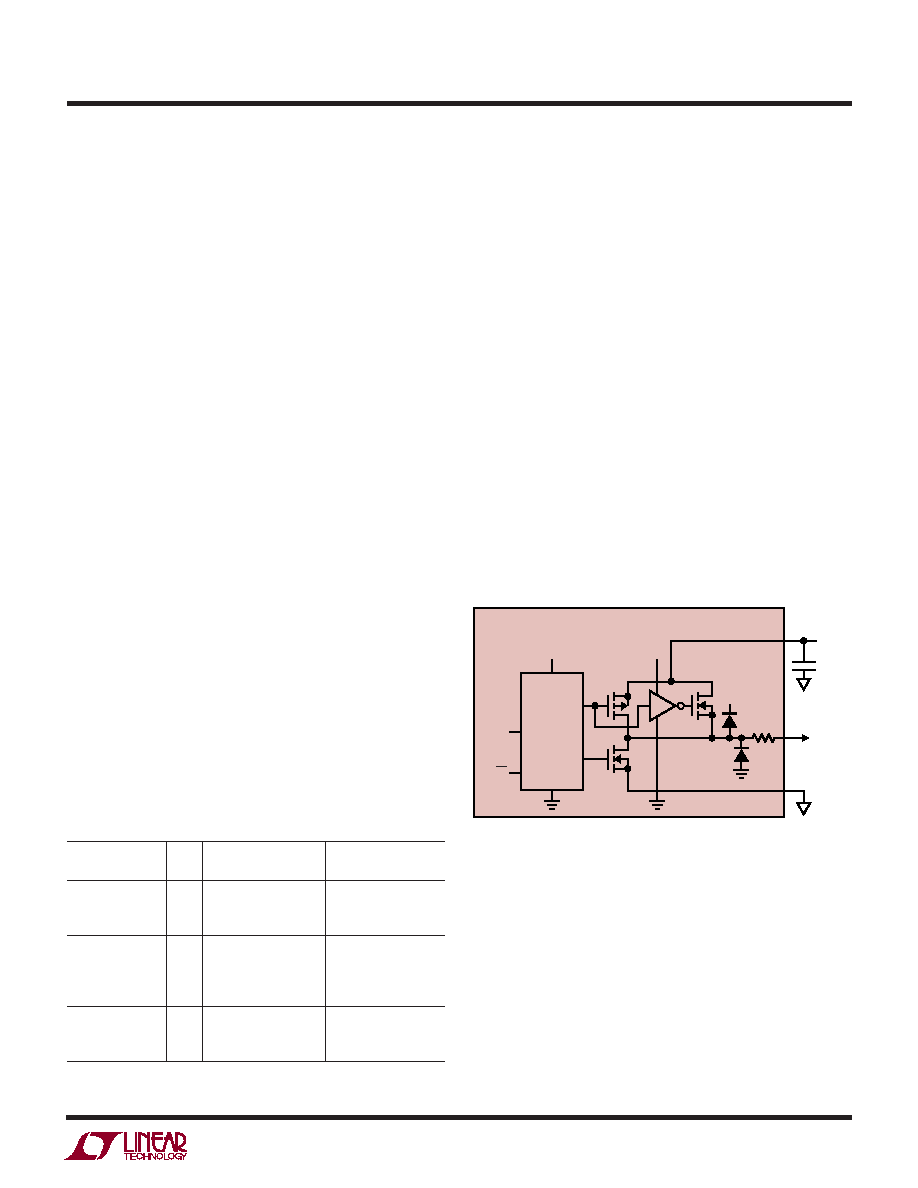- 您现在的位置:买卖IC网 > Sheet目录2005 > LTC2284CUP#PBF (Linear Technology)IC ADC DUAL 14BIT 105MSPS 64-QFN

LTC2284
17
2284fa
LTC2284
2284 F14
OVDD
VDD
0.1
F
43
TYPICAL
DATA
OUTPUT
OGND
OVDD
0.5V
TO 3.6V
PREDRIVER
LOGIC
DATA
FROM
LATCH
OE
APPLICATIO S I FOR ATIO
WU
U
Digital Output Buffers
Figure 14 shows an equivalent circuit for a single output
buffer. Each buffer is powered by OVDD and OGND, iso-
lated from the ADC power and ground. The additional
N-channel transistor in the output driver allows operation
down to low voltages. The internal resistor in series with
the output makes the output appear as 50
to external
circuitry and may eliminate the need for external damping
resistors.
As with all high speed/high resolution converters, the
digital output loading can affect the performance. The
digital outputs of the LTC2284 should drive a minimal
capacitive load to avoid possible interaction between the
digital outputs and sensitive input circuitry. For full speed
operation the capacitive load should be kept under 10pF.
Lower OVDD voltages will also help reduce interference
from the digital outputs.
Figure 14. Digital Output Buffer
architecture of this ADC relies on storing analog signals on
small valued capacitors. Junction leakage will discharge
the capacitors. The specified minimum operating fre-
quency for the LTC2284 is 1Msps.
Clock Duty Cycle Stabilizer
An optional clock duty cycle stabilizer circuit ensures high
performance even if the input clock has a non
50% duty cycle. Using the clock duty cycle stabilizer is
recommended for most applications. To use the clock
duty cycle stabilizer, the MODE pin should be connected to
1/3VDD or 2/3VDD using external resistors.
This circuit uses the rising edge of the CLK pin to sample
the analog input. The falling edge of CLK is ignored and
the internal falling edge is generated by a phase-locked
loop. The input clock duty cycle can vary from 40% to 60%
and the clock duty cycle stabilizer will maintain a constant
50% internal duty cycle. If the clock is turned off for a
long period of time, the duty cycle stabilizer circuit will
require a hundred clock cycles for the PLL to lock onto the
input clock.
For applications where the sample rate needs to be changed
quickly, the clock duty cycle stabilizer can be disabled. If
the duty cycle stabilizer is disabled, care should be taken
to make the sampling clock have a 50% (
±5%) duty cycle.
DIGITAL OUTPUTS
Table 1 shows the relationship between the analog input
voltage, the digital data bits, and the overflow bit.
Table 1. Output Codes vs Input Voltage
AIN
+ – AIN–
D13 – D0
(2V Range)
OF
(Offset Binary)
(2’s Complement)
>+1.000000V
1
11 1111 1111 1111
01 1111 1111 1111
+0.999878V
0
11 1111 1111 1111
01 1111 1111 1111
+0.999756V
0
11 1111 1111 1110
01 1111 1111 1110
+0.000122V
0
10 0000 0000 0001
00 0000 0000 0001
0.000000V
0
10 0000 0000 0000
00 0000 0000 0000
–0.000122V
0
01 1111 1111 1111
11 1111 1111 1111
–0.000244V
0
01 1111 1111 1110
11 1111 1111 1110
–0.999878V
0
00 0000 0000 0001
10 0000 0000 0001
–1.000000V
0
00 0000 0000 0000
10 0000 0000 0000
<–1.000000V
1
00 0000 0000 0000
10 0000 0000 0000
发布紧急采购,3分钟左右您将得到回复。
相关PDF资料
LTC2285CUP#PBF
IC ADC DUAL 14BIT 125MSPS 64QFN
LTC2289IUP#PBF
IC ADC DUAL 10BIT 80MSPS 64QFN
LTC2290IUP#TRPBF
IC ADC DUAL 12BIT 10MSPS 64QFN
LTC2298IUP#PBF
IC ADC DUAL 14BIT 65MSPS 64QFN
LTC2305CDE#TRPBF
IC ADC 12-BIT 2CHN 12-DFN
LTC2306CDD#PBF
IC ADC 12BIT 2CH 500KSPS 10-DFN
LTC2351HUH-12#TRPBF
IC ADC 12BIT 1.5MSPS 32-QFN
LTC2351HUH-14#TRPBF
IC ADC 14BIT 1.5MSPS 32-QFN
相关代理商/技术参数
LTC2284CUP#TRPBF
功能描述:IC ADC DUAL 14BIT 105MSPS 64-QFN RoHS:是 类别:集成电路 (IC) >> 数据采集 - 模数转换器 系列:- 标准包装:1 系列:- 位数:14 采样率(每秒):83k 数据接口:串行,并联 转换器数目:1 功率耗散(最大):95mW 电压电源:双 ± 工作温度:0°C ~ 70°C 安装类型:通孔 封装/外壳:28-DIP(0.600",15.24mm) 供应商设备封装:28-PDIP 包装:管件 输入数目和类型:1 个单端,双极
LTC2284IUP
制造商:Linear Technology 功能描述:ADC Dual Pipelined 105Msps 14-bit Parallel 64-Pin QFN EP
LTC2284IUP#PBF
功能描述:IC ADC DUAL 14BIT 105MSPS 64-QFN RoHS:是 类别:集成电路 (IC) >> 数据采集 - 模数转换器 系列:- 标准包装:1 系列:microPOWER™ 位数:8 采样率(每秒):1M 数据接口:串行,SPI? 转换器数目:1 功率耗散(最大):- 电压电源:模拟和数字 工作温度:-40°C ~ 125°C 安装类型:表面贴装 封装/外壳:24-VFQFN 裸露焊盘 供应商设备封装:24-VQFN 裸露焊盘(4x4) 包装:Digi-Reel® 输入数目和类型:8 个单端,单极 产品目录页面:892 (CN2011-ZH PDF) 其它名称:296-25851-6
LTC2284IUP#PBF
制造商:Linear Technology 功能描述:A/D Converter (A-D) IC 制造商:Linear Technology 功能描述:IC, ADC, 14BIT, 105MSPS, QFN-64
LTC2284IUP#TRPBF
功能描述:IC ADC DUAL 14BIT 105MSPS 64-QFN RoHS:是 类别:集成电路 (IC) >> 数据采集 - 模数转换器 系列:- 产品培训模块:Lead (SnPb) Finish for COTS
Obsolescence Mitigation Program 标准包装:250 系列:- 位数:12 采样率(每秒):1.8M 数据接口:并联 转换器数目:1 功率耗散(最大):1.82W 电压电源:模拟和数字 工作温度:-40°C ~ 85°C 安装类型:表面贴装 封装/外壳:48-LQFP 供应商设备封装:48-LQFP(7x7) 包装:管件 输入数目和类型:2 个单端,单极
LTC2284UP
制造商:LINER 制造商全称:Linear Technology 功能描述:Dual 14-Bit, 105Msps Low Power 3V ADC
LTC2285
制造商:LINER 制造商全称:Linear Technology 功能描述:4GHz to 6GHz High Dynamic Range Downconverting Mixer
LTC2285CUP
制造商:Linear Technology 功能描述:ADC Dual Pipelined 125Msps 14-bit Parallel 64-Pin QFN EP